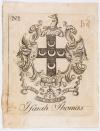A detailed list or record of the items resources held within a collection.
Inventories

|
Bookplates | The bookplate collection is arranged in two segments. One is arranged alphabetically by the last name of the owner; the other collection, institutional plates, is arranged alphabetically by the name of the city in which the institution is located. The collection was started by the Reverend Herbert E. Lombard in 1915, and substantial acquisitions occurred within the following decade. Additions to the collection are made quite frequently. When a book with a new bookplate is acquired, a photocopy is made and inserted into the collection with the provenance of the bookplate. |

|
Booksellers' and Binders' Labels | The graphic arts ephemera collection contains over 1,600 booksellers' and binders' labels. Arranged alphabetically on index cards, these labels have been acquired from collectors and book dealers over the years. In recent years, it has become routine to photocopy any labels or binders' tickets in volumes and add these to the file, along with information on the provenance of the label. |

|
Calling and Sentiment Cards | Calling cards were popular in the nineteenth century in middle and upper class society. These small cards (usually about 1.5" x 3") were used as part of the often elaborate visiting and social calling practices of the era. Cards were exchanged between new acquaintances and were used further social connections. The Society has a collection of over 600 calling cards, many homemade in manuscript and watercolor, others engraved or letter-press printed. |

|
Membership Certificates | The American Antiquarian Society has in its collection over 320 hand-lettered, engraved or relief printed certificates of membership dating from 1785 to 1946. Many of the engravings depict allegorical, genre or historic scenes illustrating an institution's founding or mission. These items, which are useful as an ephemeral resource, where intended to be framed and displayed in both domestic and business spaces; they document the birth and growth of voluntary associations in the early nation. |

|
Abigail Kelley Foster Papers, 1836-1891, Finding Aid | Abigail Kelley Foster (1811-1887), noted antislavery partisan and women’s rights advocate, was an active correspondent and lecturer on behalf of reform movements in the middle of the nineteenth century. She was married to Stephen Symonds Foster (1809-1881). |

|
American Portrait Prints | The American Antiquarian Society contains a vast collection of American portrait prints. A reference collection of over 5,000 portraits of Americans has been gathered as the Society's American Portrait Prints (APP) Collection. Arranged alphabetically by name, this collection is maintained in the Graphic Arts Department and contains images removed from newspapers, periodicals, books, letterheads, and ephemera. The Society actively collects American portrait prints dating from the late seventeenth century to the late nineteenth century. |

|
Silhouettes: An American Antiquarian Society Illustrated Inventory | The American Antiquarian Society collection of portraits contains 209 silhouettes. Silhouettes are profile portraits made of paper that became popular in the mid-eighteenth century in Europe. Generally the profile of the sitter is cut out of white paper and the resulting shape is then mounted on glossy black paper or black fabric. These portraits became very popular in the United States during the early nineteenth century. |

|
Printed Ribbon Badges: An AAS Illustrated Inventory | The Society’s collection of printed ribbons featured in this illustrated inventory includes over 170 badges ranging in date from 1824 to 1900 and includes ribbons worn to welcome Lafayette during his 1825-26 visit to the United States, mourning badges sold during the funeral of John Quincy Adams, and celebratory ribbons worn during the dedication of the Bunker Hill Monument. In the nineteenth century, ribbon badges were engraved, lithographed, or run through relief letterpress presses. |

|
Photographs of Tuskegee Institute: An AAS Illustrated Inventory | The American Antiquarian Society has a collection of fifty-six photographs depicting life in and around Tuskegee Institute, in Tuskegee, Alabama, ca. 1890-1915, taken by an unknown photographer. The campus, now known as Tuskegee University, is depicted here during the tenure of the school’s first president Booker T. Washington. Under Washington's leadership, students learned trades while also constructing the school's buildings brick by brick. |

|
Photographs of the New England Fair by B.T. Hill: An AAS Illustrated Inventory | The American Antiquarian Society contains a collection of glass plate negatives taken by Benjamin Thomas Hill (1863-1927), at the Worcester County Agricultural Society's fairgrounds in the early decades of the twentieth century. The photographs depict the fairgrounds behind Norton Company in the city’s Greendale neighborhood. The fairgrounds were lost about 1947 when Norton Company bought the land and expanded its business. |